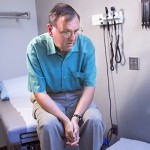Understanding Suffering
Empathy is about standing in someone else’s shoes, feeling with his or her heart, seeing with his or her eyes. ~ Daniel H. Pink
People who are in the healthcare system on a chronic basis know suffering. Some of it is due to  their condition, but some of it is caused by the system itself. Here’s a scenario we are all too familiar with:
their condition, but some of it is caused by the system itself. Here’s a scenario we are all too familiar with:
You take time off from work to see your provider. Your appointment is at 1 and it is now 1:30. You have a meeting at 3:30 and your boss has been worrying about the amount of time you have been away.
Although some people are charging their physicians for time they had to wait for their appointments, the money may not fix the employer’s concern.
Or worse still,
you are in the hospital and have to use a bedpan. You ring the nurse and wait 5 minutes. You are desperate and ring the nurse again. After holding for 10 more minutes, you soil yourself just before the nurse arrives. Then you must go through a bath, bed change and listen to the sighs of the nursing assistants.
Or even worse,
you are left on a bedpan and develop bedsores from the experience.
These experiences may seem minor, but they are not. Misery, distress and pain may be part of sickness, its diagnosis and treatment; but this type of suffering is caused by dysfunctions in the healthcare system itself–preventable suffering.
“First Do No Harm.”
The above quote is attributed to Hippocrates in the 4th century BC. Are the places where we receive care following this admonition? Not according to these statistics:
- around one in 25 people who are hospitalized will contract at least one infection during their stay in the hospital.
- Every day, there is a medication error in the hospital. It is estimated that about a million
 medication errors happen each year that result in around 7000 deaths.
medication errors happen each year that result in around 7000 deaths. - Between 7% and 26% of abnormal critical lab tests are not communicated to the patient in a “timely manner.”
Medical Education As Part of the Problem
A National Patient Safety Foundation White Paper points to medical schools as being part of the problem. To wit, medical schools are not teaching communication skills, team building concepts or what is called “human factors principles.”
Human factors engineering seeks to create processes that improve efficiency, creativity and satisfaction and reduce errors. Here’s an example: Suppose a physician instructor is explaining a complicated surgical procedure while instructing a student. Because of the complexity of doing both activities at the same time, mistakes happen. Human factors engineering searches for ways to change the process so that instruction occurs and the operation is successful.
 The National Patient Safety Foundation’s Expert Roundtable also faults the culture of medical schools.
The National Patient Safety Foundation’s Expert Roundtable also faults the culture of medical schools.
“medical students all too often suffer demeaning experiences at the hands of faculty and residents…Behaviors like these that are disruptive to professional relationships have adverse effects upon students, residents,nurses, colleagues, and even patients. Students…tend to emulate these behaviors as they become residents and practicing clinicians, which perpetuates work environments and cultures that are antithetical to the delivery of safe, patient-centered care.”
Reducing Suffering
Could a greater miracle take place than for us to look through each other’s eyes in an instant? ~Henry David Thoreau
Beyond improving medical education, what else can be done? Already change is occurring. The discussion of patient-centered care is key to improvement. Involving patients in conferences is crucial.
The Cleveland Clinic is one facility leading the way to reduce preventable suffering. They are implementing a trademarked framework created to move healthcare organizations from being volume-based to becoming value-based and patient-centered called Compassionate Connected Care™.
What does Compassionate Connected  Care™ look like?
Care™ look like?
In a collaboration between over 100 providers and patients, these “themes” emerged.
-
Suffering Must Be Acknowledged: We should acknowledge that our patients are suffering, and show them that we understand.
-
Body Language Matters: We must employ non-verbal communication skills and treat them as equally important as the words we use.
-
Anxiety is Suffering: We must acknowledge anxiety and uncertainty as negative outcomes and address them as part of the patient experience.
-
Care Should be Coordinated: We should show patients that their care is coordinated and continuous, and that “we” are always there for them.
-
Caring Transcends Diagnosis: We must embrace the reality that care goes beyond delivery of medical interventions to the patient.
-
Autonomy Reduces Suffering: We must help preserve autonomy as a means to ensure patient dignity.”
For each theme, a series of actions are to be implemented.
At the 6th Patient Experience Empathy and Innovation Summit held at Cleveland Clinic this past  May, Christy Dempsey, RN presented the Compassionate Connected Care™ Framework. In her talk she challenged clinicians to learn one thing about each patient that has nothing to do with the reason they are hospitalized. “It takes 56 seconds to make a connection with a patient,” she said.
May, Christy Dempsey, RN presented the Compassionate Connected Care™ Framework. In her talk she challenged clinicians to learn one thing about each patient that has nothing to do with the reason they are hospitalized. “It takes 56 seconds to make a connection with a patient,” she said.
Less Than A Minute
Just think: less than a minute can provide a person with a connection, a sense of dignity. Less than a minute can transcend diagnosis, reduce anxiety perhaps even reduce suffering. Seems a small price to pay, doesn’t it?
What do you think? Have you experienced preventable suffering in the healthcare system? What actions are needed to reduce preventable suffering? How would you reduce suffering in healthcare?
Below is a video produced by Cleveland Clinic.

![Reduce Suffering In Healthcare [Video]](https://medivizor.com/blog/wp-content/uploads/2015/07/suffering-640X320.jpg)




I have been hospitalized a few times. Sometimes hospitals are short staff either due to some being sick or budget issues. If hospital staff showed more empathy towards the patient, the recovery time would be easier and the patient being understood.
IT TAKES TWO FOR A TANGO. COURTESY IS RECIPROCAL. PATIENTS TOO SHOULD SEE THINGS THROUGH THE EYES OF HEALTHCARE WORKERS.
I’ve read the post with great satisfaction and even could understand
something new that I will use for your own further requirements.